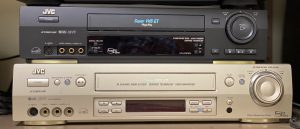Ode to the VCR
 Yesterday, June 7th, was National VCR Day! Machines to record on videotape were introduced in the 1950s, which was the beginning of the death knell for the kinescope, but they were so expensive (around $50,000 in 1956!) that only television networks and large stations were able to afford them.
Yesterday, June 7th, was National VCR Day! Machines to record on videotape were introduced in the 1950s, which was the beginning of the death knell for the kinescope, but they were so expensive (around $50,000 in 1956!) that only television networks and large stations were able to afford them.The first commercial VCRs for home use were released in the 1970s. Betamax and Jack Valenti were soldiers in this format (and popular culture) war. In the early 1980s, the U.S. Supreme Court ruled against film companies, stating that the VCR was allowable for private use and it was legal to make recordings of television shows at home. The popularity of the VCR exploded and with the reduction in price, by the 1990s, almost every home had a VCR.
In the late 1990s and 2000s, new technologies like DVDs, Blu-ray discs, and finally streaming services made the VCR obsolete and the last was produced in 2016.
Special Collections and Archives, a part of the Missouri State University Libraries, keeps and maintains a number of VCRs for viewing and digitizing videocassettes. The videocassette recorders shown here are stored on what we like to call our “Wall of Outdated Technology,” where they hang out with other machines such as wire recorders, turntables, reel-to-reel machines, and 8-track tape players!
Do you still have an old VCR hiding somewhere in your home? You might want to hang on to that! With working machines selling for big bucks on the internet and resale stores, it could be worth a pretty penny as people seek out the machines to digitize their videocassette collections.